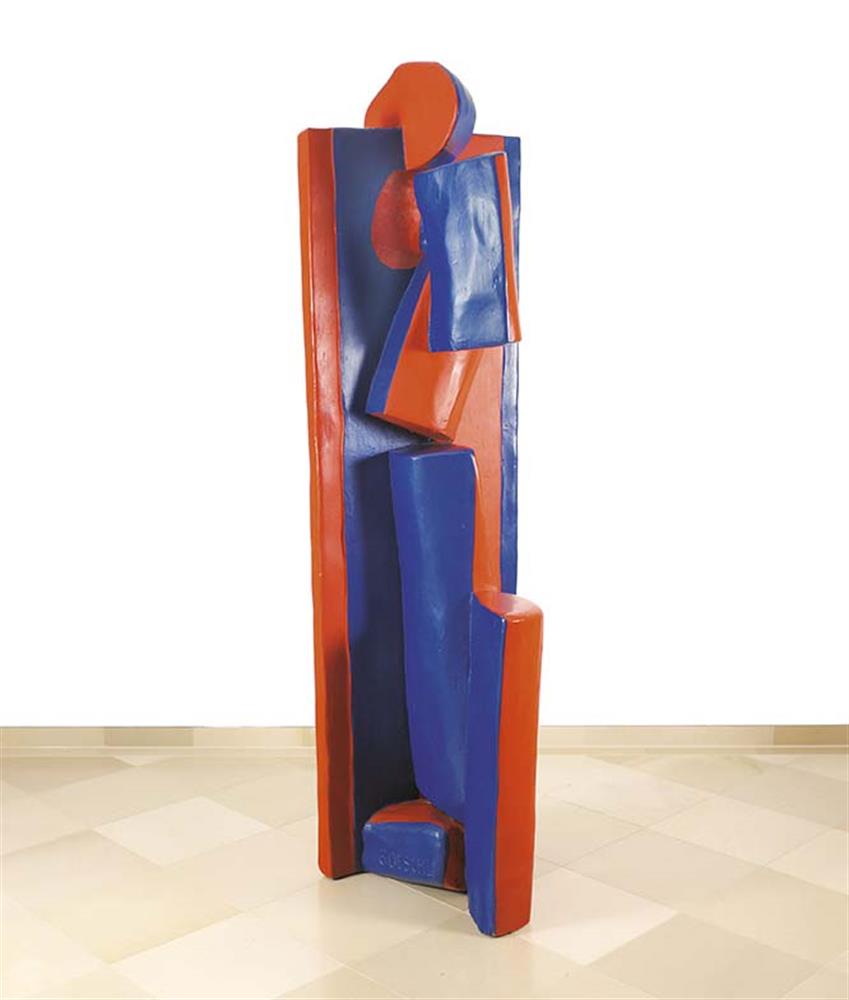
Salzburg 1932 - 2016 Vienna
Figure Stepping into the Room
Unique pieceWood, lacquered
H 215 cm, W 63 cm, D 63 cm
Signed: GOESCHL
Literatur:
Exhibition catalogue "Ingeborg G. Pluhar. Roland Goeschl. 1963-1966", Österreichische Galerie Belvedere, Vienna 1994, ill. p. 27, p. 57 and p. 59
Exhibition catalogue "Roland Goeschl. Rückblicke 1957-2005: Bilder Fotos Modelle Skulpturen", ed. by Tobias G. Natter, Franz Smola, Österreichische Galerie Belvedere, Vienna 2006, ill. p. 55
Roland Goeschl was born in Salzburg in 1932. He attended the Summer Academy in Salzburg in 1955 and studied at the Academy of Fine Arts in Vienna from 1956 to 1960 under Fritz Wotruba, whose assistant he was from 1963 to 1966. In 1962 Goeschl worked nine months at Royal College of Art in London. His works were shown in many national and
international exhibitions, including twice at the documenta in Kassel (1964 and 1968), and the Venice Biennale in 1968. In 1994, a room design by Roland Goeschl was presented at the Vienna Secession, while the Österreichische Galerie Belvedere devoted a comprehensive retrospective show to him in 2006. From 1972 onwards, Goeschl was Professor of Drawing and Painting at the Technical University in Vienna. Numerous works of the artist are exhibited in public space, examples being in Vienna’s Technical University and in the Messezentrum Salzburg. Goeschl, whose work builds on constructional principles of design, counts among Austria’s most important representatives of Concrete Art. The sculptor, painter and art expert died in Vienna in 2016. The Museum der Moderne Salzburg and the Österreichische Galerie Belvedere paid tribute to the artist in a posthumous exhibition in 2017.
Werner Hofmann saw ‘foreign objects’ in Goeschl’s figures: ‘[…] Goeschl produces such foreign objects. He does not put them up on pedestals, rather places them in the way. They crop up with the suddenness of a robbery. Neither streets nor squares […] are safe from them. Their sheer ruthlessness knows how to gain access anywhere. In this way,
colourful, physical interventions, raids, break-ins take place in the dull accumulation of urban landscape. Goeschl’s incisions demonstrate how soft and amorphous is what is described (without considering the negative connotation in German) as the Weichbild (or municipal area) of a city. These subversive volumes are monuments or Denk-Male in the
truest sense of the word – ‘ just think’. They are not venerable monuments as reminders, rather colourful three-dimensional objects that provoke thought […]’. Goeschl reversed the 19th century notion of the monument and wanted to create ‘architecture’ with his sculptures that encroached upon space. Quoting Otto Breicha: ‘[…] if he could do as he wished, there would everywhere be colour-spatial arrangements of an architecture according to the measure of the sculpture […]’.1
1 Exhibition catalogue ‘Ingeborg G. Pluhar. Roland Goeschl. 1963–1966’, Österreichische Galerie Belvedere, Vienna 1994, p. 29
